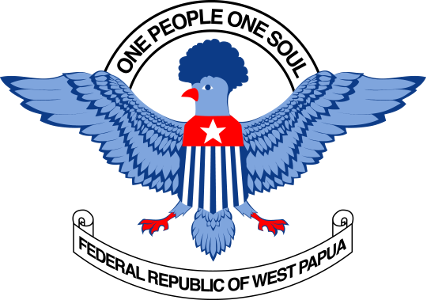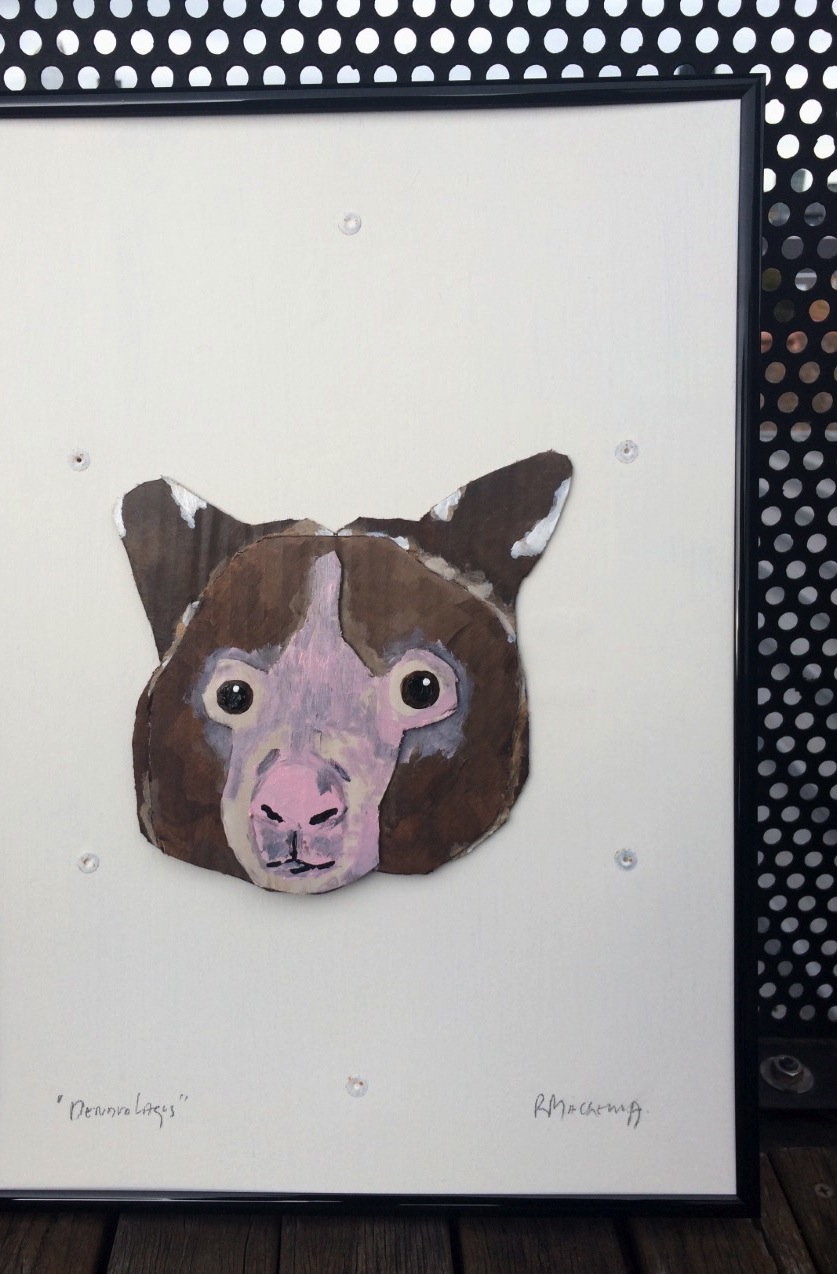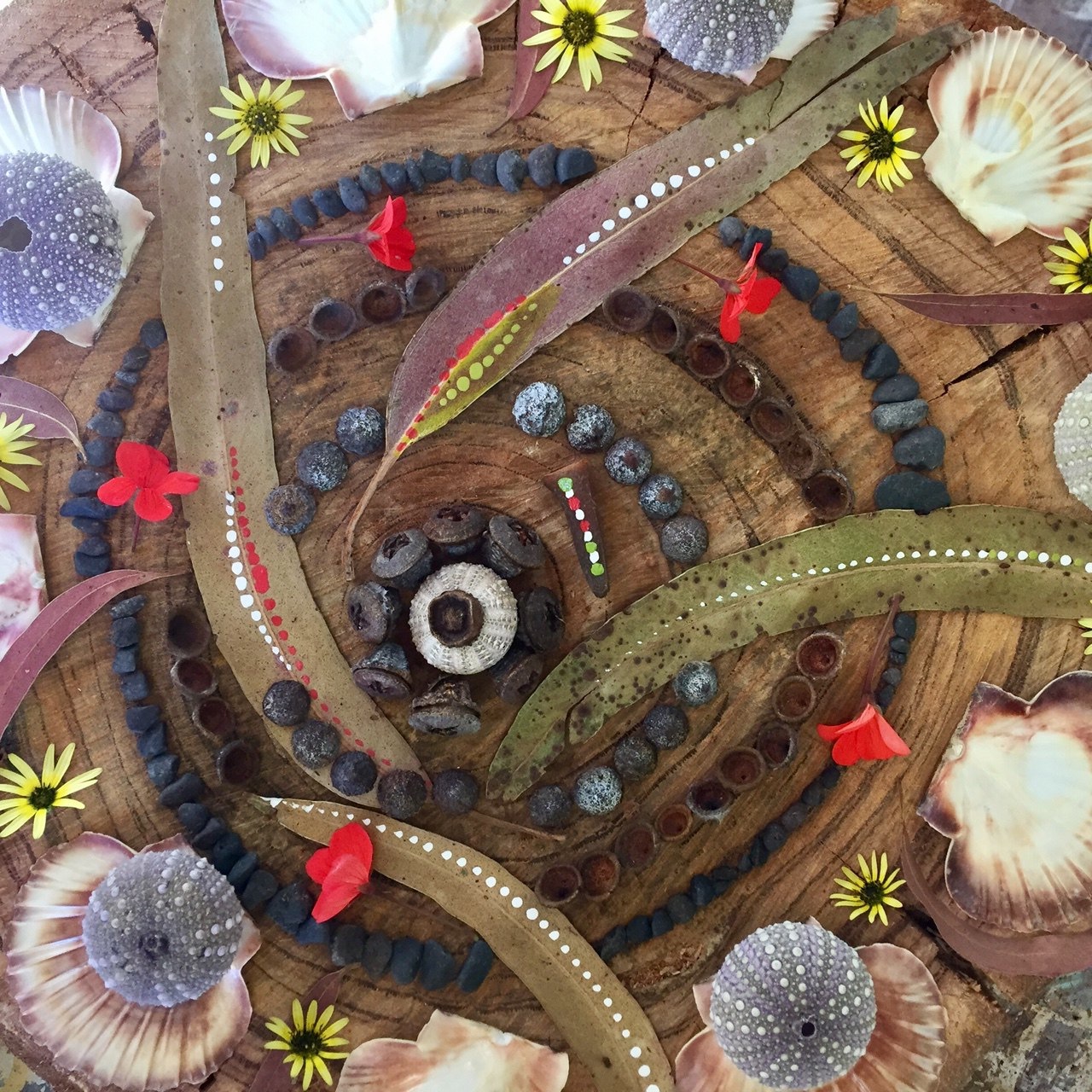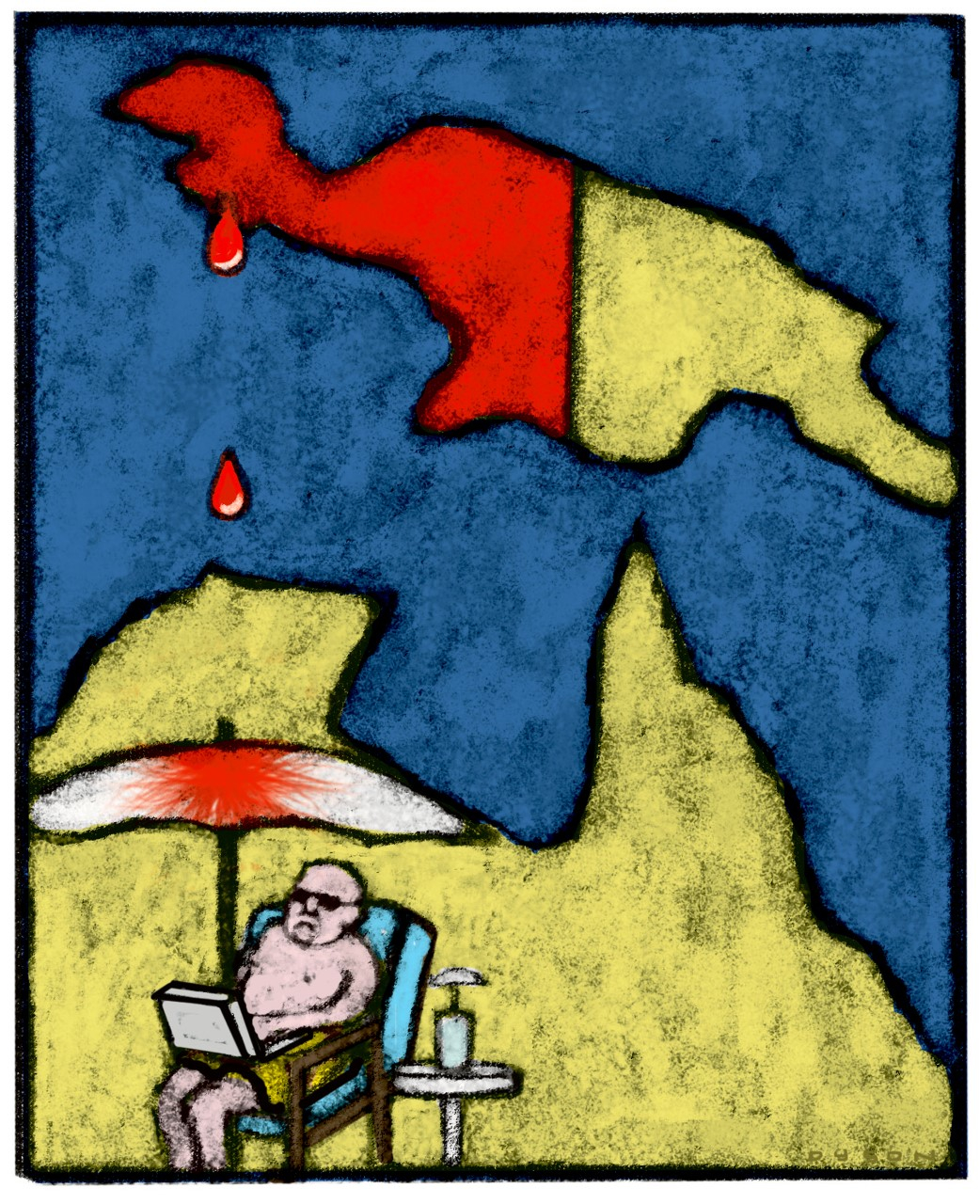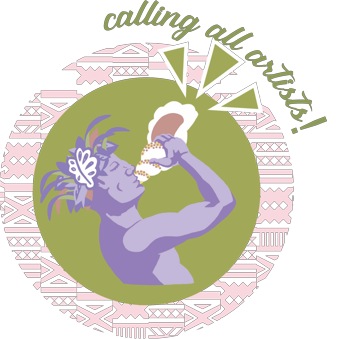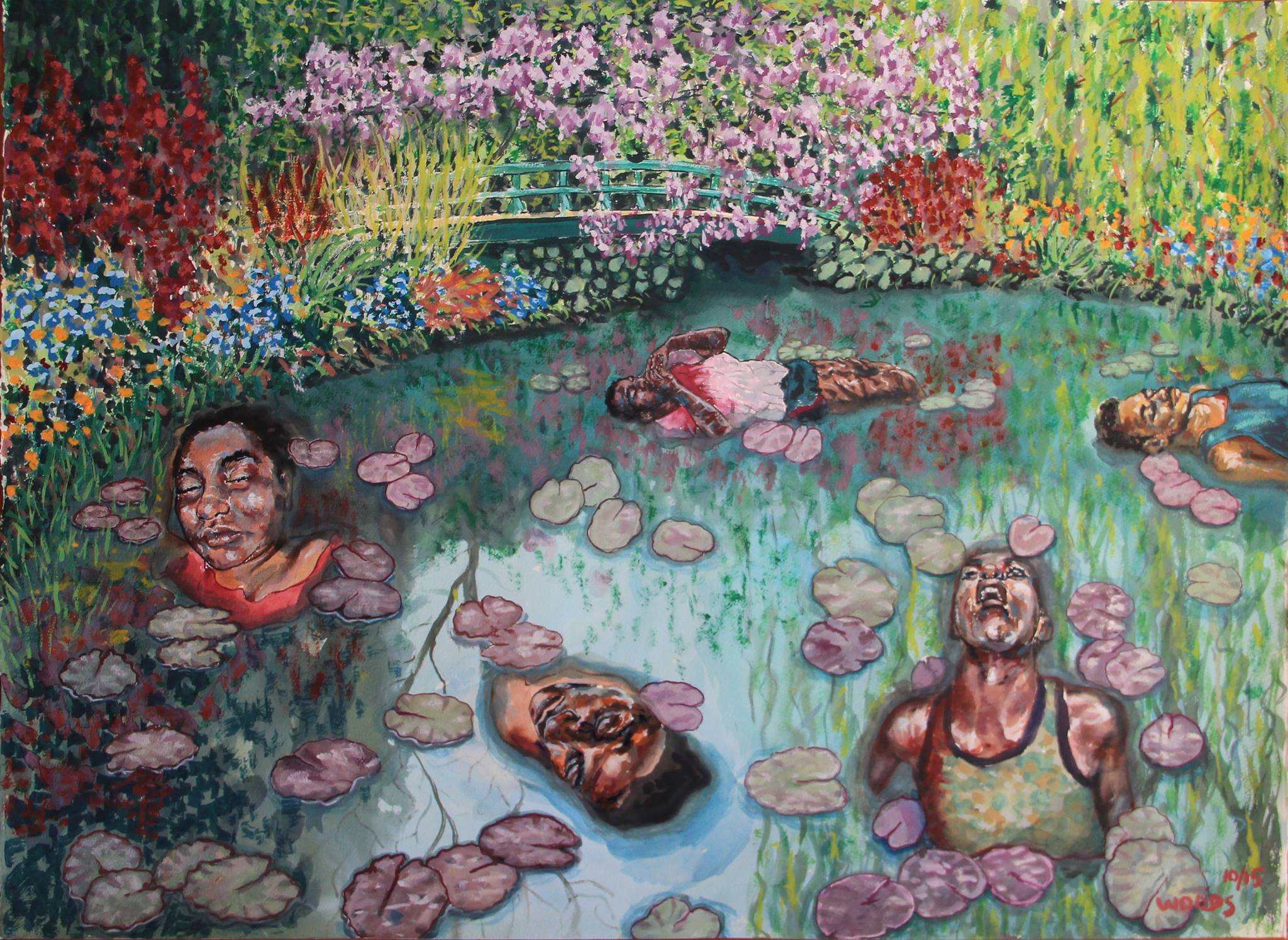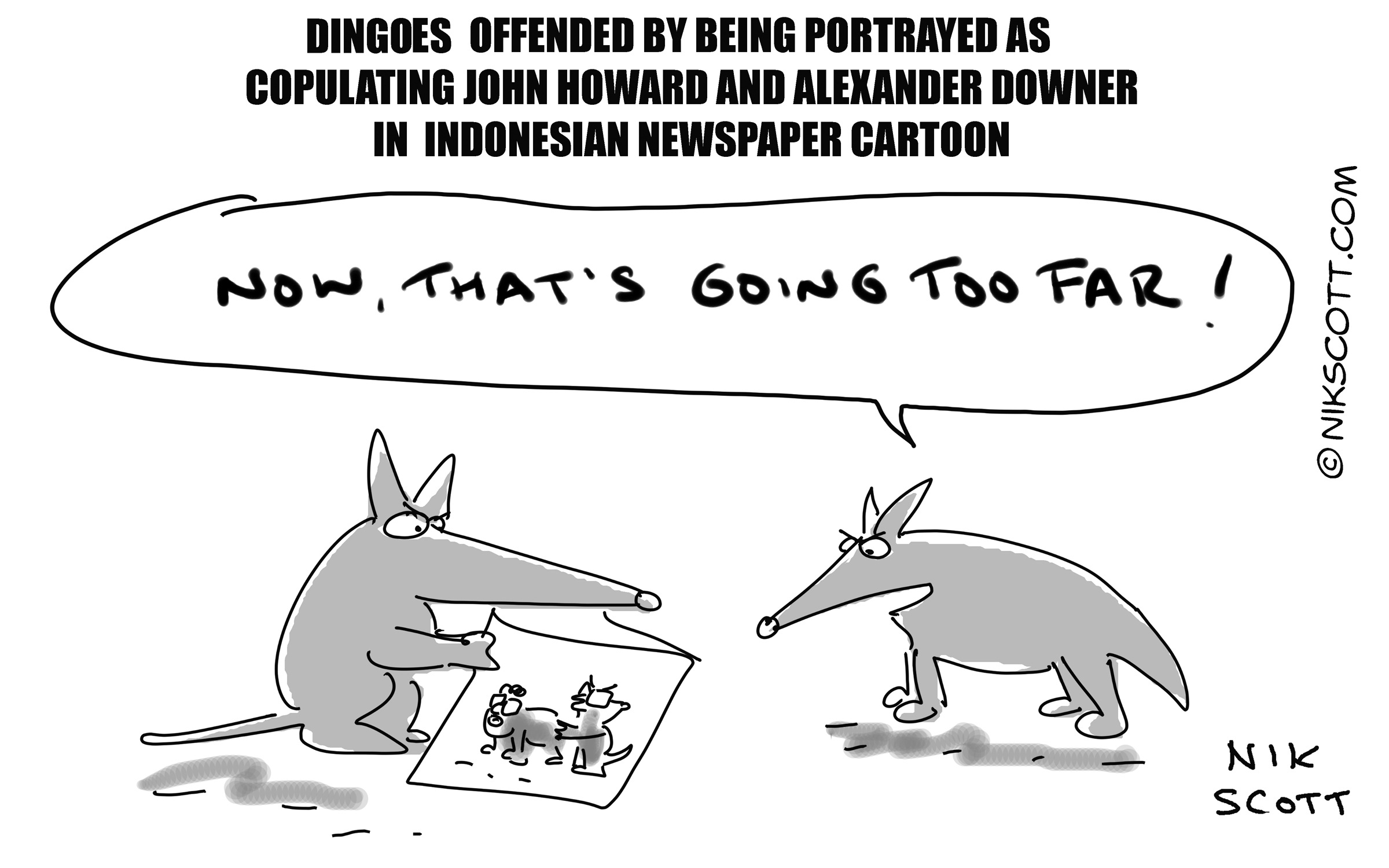
CARTOON EXHIBITION at 2016 Sampari Art Exhibition & Sale for West Papua ACU ART GALLERY, 26 Brunswick St, Fitzroy (2-11 December 2016)

ANDREW DYSON Avoiding the real West Papua The Age, 15 May 2006. © ANDREW DYSON
An exhibition of twenty-nine works by Australia’s most gifted and beloved cartoonists published in 2006 after the arrival of forty-three West Papuan asylum seekers. The cartoons narrate and amplify the war-of-words between Canberra and Jakarta, and between Australian politicians, over an illusory line between the refugees’ genocidal claims and Indonesia’s racist militarized rule in the former Dutch colony. That Australia’s powerful media moguls published (rather than shelved) their employees’ works suggests that they too believed it was time to question Australia’s long-standing support of the Indonesian occupation.
The Cartoon Exhibition was sponsored by TAKING OFF TOURS in St Kilda Road and UNITED IMAGE PHOTOGRAPHY in Prahan. Eight of the beautifully printed works were sold. The cartoonists retain copyright of their cartoons, but most gifted the remaining prints to the FRWP Womens Office in Docklands. The exhibition images are reproduced here, in low resolution, with explanatory text. The newspaper articles that many of them illustrated, along with the Exhibition Catalogue, in PDF form, are reproduced at the end of the essay.

DAMIEN BAKER 43 West Papuan asylum seekers at Mapoon in Far North Queensland Torres News, Mer Island, 17 January 2006. © DAMIEN BAKER
2006 began for West Papua watchers on 17 January with a photo on the internet of forty-three West Papuans relaxing under a tree alongside a double-outrigger canoe bearing a banner SAVE WEST PAPUA PEOPLE FROM GENOCIDE. The asylum seekers had left Jayapura on the north coast of West Papua early in December 2005, had circumnavigated their huge half-island homeland, then crossed the perilous Torres Strait to Mapoon on the the west coast of Cape York Peninsula, all without modern navigation tools.
Australian Quarantine, Customs, and Police found the West Papuans moments before Damien Baker and Corey Bousen from Torres News. The journalists had managed to convinced the Murdoch newspaper in Cairns to hire a helicopter for them after they’d heard on the Aboriginal grapevine that the Papuans were three days overdue. However, the Papuans had beached and self-reported the previous day, and Baker’s first photo was of a government helicopter encircling the refugees trying to enforce a new 32km ‘no fly zone’. (Mapoon had a population of 239 Aboriginal and Torres Strait descendents in 2006). Later in the day the asylum seekers were taken 80 kms down a dirt track to Weipa, and then flown 4,000 kms across Australia to a detention centre on Christmas Island in the Indian Ocean just 500 kms south of Jakarta.

PAT CAMPBELL West Papua, welcome to democracy The Canberra Times, January 2006. © PAT CAMPBELL
PAT CAMPBELL captured the pain of the West Papuan mothers, hesitating to put their children on the canoe to Australia. He has them being lifted to the kangaroo’s [closed] pouch by a Victoria Crowned Pigeon, the symbol adopted by the West Papuan parliament (Nieuw Guinea Raad) on 19 October 1961 alongside the Morning Star flag and National Anthem. Seven of the 43 asylum seekers were minors (twin-boys aged three, a four-year-old girl, two fourteen- and two sixteen-year-old boys); four of them unaccompanied minors for whom Amanda Vanstone, as Minister for Immigration, became legal guardian. She employed David Manne, a fearless lawyer from the Refugee Immigration Legal Centre to prepare their claims, and the advice of Paris Aristotle from the Foundation for Survivors of Torture about settling them in Melbourne under the stewardship of Jacob Rumbiak, a respected leader of West Papua’s independence movement.
Meantime, Custom officials burned EXODUS, the asylum seekers hardy little canoe, hand-hewn from a special ‘canoe tree’ planted decades before. Foreign Affairs was busy fishing for a darker motive than Genocide. A war-of-words was erupting between Canberra and Jakarta. President Yudhoyono fired the first shot, demanding the Australian Prime Minister return the West Papuans to Indonesia, claiming he would personally ‘welcome them back with open arms’, arguing that Australian protection visas would undermine his nation’s sovereignty and territorial integrity. Howard, however, against Immigration Minister Vanstone’s stout determination to uphold Australia’s legal obligations in terms of the UN Convention on Refugees, was unable to oblige the Indonesian President (whose country has never signed the convention).

IAN SHARPE I saw a man who wasn’t there The Canberra Times 22 January 2006. © IAN SHARPE

PAUL ZANETTI 43 asylum seekers land January 2006. © PAUL ZANETTI

JON SPOONER The Foreign Affairs Department prepares a traditional refugee welcome The Age, 8 April 2006. © JON SPOONER

JON SPOONER The Foreign Affairs Department adopts a pragmatic and principled position The Australian, 11 April 2006. © JON SPOONER

PETER NICHOLSON We’ll welcome them back with open arms The Australian, 25 March 2006. © PETER NICHOLSON

JON KUDELKA The Australian, 2 May 2006. © JON KUDELKA
On 24 March 2006, the Immigration Department artfully ignored the warnings of senior Foreign Affairs officials and issued the West Papuans with protection visas on the basis of “well founded fears of persecution”. Rakyat Merdeka, a newspaper in Jakarta, commissioned cartoonist FONDA LAPOD to pen an appropriate response. Lapod drew a dingo, in the guise of Prime Minister Howard mounting another dingo in the guise of Foreign Affairs Minister Downer, saying “I want Papua Alex, make it happen”. By the time BILL LEAK’s equally controversial rejoinder was published by The Australian a few days later, President Yudhoyono had recalled his ambassador and was threatening to review Indonesia’s cooperation with Australia over people-smuggling and counter-terrorism. West Papuans who saw these two cartoons at the Cartoon Exhibition were shocked that Indonesians and Australians would condone such crude portraits of their leaders.

FONDA LAPOD The adventure of two dingo Rakyat Merdeka, 27 March 2006. © FONDA LAPOD

BILL LEAK Don’t take this the wrong way, no offence intended, as Indonesia fornicates with Australia The Australian, 1 April 2006. © BILL LEAK

PETER NICHOLSON SBY recalls ambassador on West Papuans The Australian, 4 April 2006. © PETER NICHOLSON

PETER NICHOLSON We will decide who comes to Australia The Australian, 8 April 2006. © PETER NICHOLSON

NIK SCOTT Dingoes offended being portrayed as John Howard and Alexander Downer copulating in Indonesian newspaper cartoon 29 March 2006. © NIK SCOTT
To appease Indonesia, Prime Minister Howard developed legislation to immunize Australia from West Papuan asylum seekers. The MIGRATION AMENDMENT BILL 2006 that he introduced to Parliament blocked access to Australia for all boat people and warehoused them in another country, out of reach of the Australian media and the Australian legal system.

PETER NICHOLSON Excision beaches refugees zone The Australian, 13 April 2006. © PETER NICHOLSON

JOHN DITCHBURN Australia’s coastline The Courier, Ballarat. © JOHN DITCHBURN
DAVID POPE in Refugee Pinball paints a work-a-man prime minister telling his Immigration Minister ‘we’ve disabled the tilt’, meaning he was confident his Migration Amendment Bill 2006 would restore the relationship with Indonesia that her asylum of the the West Papuans had lacerated. Vanstone, a veteran politician who will always be remembered for her ingenious protection of the Papuans’ claims from interference by the Prime Minister and the Department of Foreign Affairs, is seen rifling through a travel magazine, apparently already aware that Howard would sack her, as he did a few months later and sent her to the Italian Embassy in Rome.

DAVID POPE Refugee pinball The Sun-Herald, 23 April 2006. © DAVID POPE
The Migration Amendment Bill 2006 was so brutal that three of Howard’s colleagues—PETRO GEORGIOU, RUSSELL BROADBENT, JUDI MOYLAN—crossed the floor in the House of Representatives and voted against the bill. Despite this, and Broadbent’s plea “If I am to die politically because of my stance on this bill, it is better to die on my feet than to live on my knees” the bill passed by a narrow majority.

PETER NICHOLSON Rebel Liberals may cross floor The Australian, 10 August 2006. © PETER NICHOLSON

PETER NICHOLSON Reality shows on border protection The Australian, 10 August 2006. © PETER NICHOLSON

MARK KNIGHT The Australian keeper The Herald Sun, 21 June 2006. © MARK KNIGHT

BILL LEAK Asylum Seeker-Migration Amendment Bill 2006 The Australian, 10 Aug 2006. © BILL LEAK
The Migration Amendment Bill 2006 was thoroughly rejected by a Parliamentary sub-committee chaired by Liberal Senator MARISE PAYNE, which noted it breached Australia’s international legal obligations and “represents deficient foreign policy, in terms of a perceived attempt to APPEASE Indonesia over the situation in West Papua”. However, John Winston Howard — who by 2006 had been prime minister for ten years, winning second, third and fourth terms in 1998, 2001, 2004 — was still confident he would get his legislation through the Senate. GEOFF PRYOR has him karaoking with well-known Indonesian political and military identities.

GEOFF PRYOR Karaoke Night 19 June 2006. © GEOFF PRYOR

MATTHEW DAVIDSON Can Howard find refuge? The Age, 14 May 2006. © MATTHEW DAVIDSON

JON SPOONER The new prime minister of Australnesia The Age, 15 June 2006. © JON SPOONER

BILL LEAK Indonesian President Susilo Bambang Yudhoyono and Australian Prime Minister John Howard relax The Australian, 11 August 2006. © BILL LEAK
Subsequent to an extraordinary grass-roots campaign by people and organisations right around Australia, Senators JUDITH TROETHE and BARNABY JOYCE (from the Coalition Government) and STEVE FIELDING (Family First Party) said they would join Labor and The Greens to vote against the Migration Amendment Bill in the Senate. Facing defeat, Howard quietly withdraws his scandalous legislation.

MARK KNIGHT PM overboard-Migration Bill The Herald Sun, 15 August 2006. © MARK KNIGHT
With West Papua proving to be such a hot and enduring media issue since January, Channel 9 and Channel 7 decided, in September, to go cannibal-hunting in the forbidden province. Channel 9’s Sixty Minutes found Wawa, a ten-year-old boy under threat of being eaten by his tribe and managed to save him. Channel 7’s Today Tonight crew was less lucky, with all arrested by the Indonesian authorities for trying to enter West Papua on a tourist visa. PETER NICHOLSON, who produced eight cartoons about West Papua in 2006, meticulously lampooning Howard’s ridiculous war against self-determination, painted Channel 7 host Naomi Robson’s adventure in colour as well as black-and-white.

PETER NICHOLSON Naomi Robson arrested in West Papua The Australian, 15 Sept 2006. © PETER NICHOLSON

PETER NICHOLSON Naomi Robson with cannibal tribes The Australian, 16 September 2006. © PETER NICHOLSON
Meanwhile Indonesia was still waiting opportunistically to be adquately recompensed for the non-refoulement of its 43 citizens. Foreign Affairs Minister Downer dug deep and found a draft of an old security treaty, re-negotiated it, and signed it as the LOMBOK TREATY with his Indonesian counterpart Hassan Wirajuda in November 2006. (Indonesia tore up the 1995 Suharto-Keating agreement after Australia led a 22-nation peace-keeping force into East Timor in 1999). The Lombok Treaty includes an outlandish clause that outlaws discussion or display, in Australia and Indonesia, of any form of West Papuan political identity. This would include, for example, a white star woven into a hand-bag or wristband, or sewn onto a flag, or drawn on a car sticker). JON SPOONER, as usual, captured the realpolitik of the treaty, and also the paralysing revulsion of many Liberals for most aspects of Indonesian governance in West Papua.

JON SPOONER The things you see by a green light The Age, 9 Nov 2006. © JON SPOONER
In the final cartoon BILL LEAK reflects a view of Indonesia as ‘the neighbour from hell.’ This was also the view, though not expressed in Leak’s particular vernacular, of SIR GARFIELD BARWICK after voting for the New York Agreement in the 1962 UN General Assembly (by which Indonesia gained administrative rights in Netherlands New Guinea and thus became Australia’s closest neighbour as well). Barwick believed Indonesia’s claim should have been resolved in the UN’s INTERNATIONAL COURT OF JUSTICE; preferred ‘for the sake of the indigenous inhabitants’ that the Netherlands administration remain …. and stressed that the long-term interests of stability and progress in the region would only will be served if Indonesia delivered a BONA FIDE PERFORMANCE of the self-determination provisions of the NEW YORK AGREEMENT (see below: Official Recods, UNGA, 17th Session, 1127th Plenary Meeting, 21 September 1962:3pm).

BILL LEAK The neighbour from hell The Australian. © BILL LEAK
CARTOON EXHIBITION ADVERTISEMENT

CARTOON EXHIBITION CATALOGUE (click to print)
Cartoon Exhibition Catalogue, Sampari 2016
SELECTED NEWSPAPER ARTICLES FROM 2006
1. Vanstone refuses to return Papuans, Sydney Morning Herald, Tom Allard, 18-20 Jan 2006
2. On the ground with the West Papuan asylum seekers, Crikey, Corey Bousen, 19 Jan 2006
3. Christmas Island detention places Papuan families in direct murder danger, Project Safecom, Media Release, 26 Jan 2006
4. What happens now we’ve got 43 West Papuans, Louise Byrne
5. Below a mountain of wealth, a river of waste, New York Times, 27 December 2005
6. John Pilger on West Papua and why the ghosts of Indonesia won’t lie, New Statesman, 13 Mar 2006
7. Papua anger focuses on world’s richest mine, Asia Times, John McBeth, 23 Mar 2006
8. Visa ruling puts Jakarta ties at risk, Sydney Morning Herald, Tom Allard, 24 Mar 2006
9. West Papua, Long boat to freedom, Transcript, SBS Dateline, Mark Davis, 29 Mar 2006
10. Howard unfazed by sex cartoon, BBC News, 30 Mar 2006
11. Australian cartoon irks Indonesia, BBC News, 1 Apr 2006
12. Free at last, West Papuan refugees rejoice in new dawn, The Age, Andra Jackson, 4 Apr 2006
13. The point of no return, The Age, Andra Jackson, 6 Apr 2006
14. Ignoring the lesson of East Timor, The Age, Mark Baker, 8 Apr 2006
15. Politically pesky Papuans, ABC-RN, 9 Apr 2006, Di Martin
16. Our duty to West Papua, The Age, Huge White, 11 Apr 2006
17. Indonesia threatens Australia over Papuan refugees, Australian News Commentary, 24 Apr 2006
18. Boatloads of Extinguishment? David Manne, Castan Human Rights Law Centre, 5 May 2006
19. Can Howard find refuge, The Age, Michelle Grattan, 14 May 2006
20. Avoiding the real West Papua, The Age, Scott Burchill, 15 May 2006
21. Backbenchers revolt over asylum changes (Senate Committee), Lateline, 13 Jun 2006
22. Answering to Jakarta, The Age, Scott Burchill, 15 June 2006
23. Indonesians accused of torture, The Age, Andra Jackson & Sarah Smiles, 27 June 2006
24. What’s wrong in Papua, The Age, Kenneth Davidson, 29 Jun 2006
25. No government spin will undo Australia’s dirty push-back deals with Indonesia, Project Safecom, 10 Aug 2006
26. The Coalition Rebels speak out, Project Safecom, 10 August 2006
27. The flotsam downflow from Indonesia, Project Safecom, 10 August 2006
28. Fielding gets refugee version of border protection, The Age, 12 Aug 2006
29. Low population in Papua an indication of genocide, Radio New Zealand, 17 Aug 2006
30. Good neighbour, bad neighbour, what’s the difference, Jesuit Social Justice Centre, Adelaide, Tony Kevin, 22 Aug 2006
31. A new diplomacy over Papua, The Australian, Paul Kelly, 7 Oct 2006
32. Canberra’s treaty killing off Papuan democracy, The Age, 9 Nov 2006
33. Lombok Treaty, Article 2, 13 Nov 2006
34. Lombok Treaty, The Interpreter, Hugh White, 7 Mar 2008
35a. Garfield Barwick, UNGA, New York, 21 Sept 1962, 3pm, p53
35b. Garfield Barwick, UNGA, New York, 21 Sept 1962, 3pm, p54
35c. Garfield Barwick, UNGA, New York, 21 Sept 1962, 3pm, p55
CARTOON EXHIBITION SPONSORS

TAKING OFF TOURS TRAVEL AGENCY 618 St Kilda Rd, Melbourne
TEL (03) 9521 1475

UNITED IMAGE PHOTOGRAPHY 24 Macquarie St, Prahran, Victoria
TEL 0412 211 773
